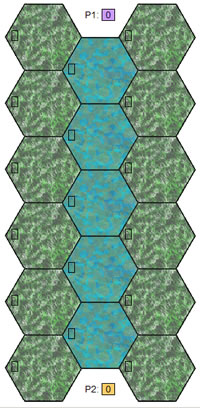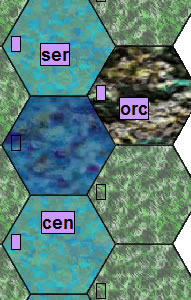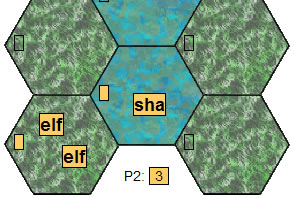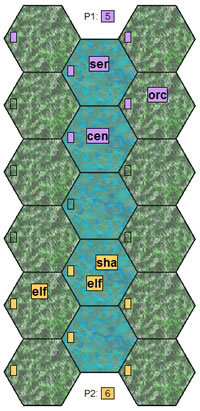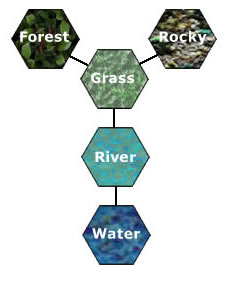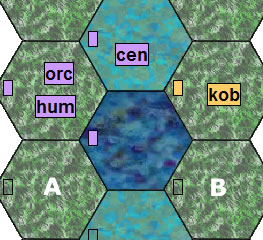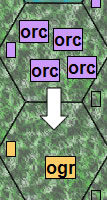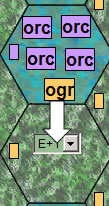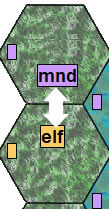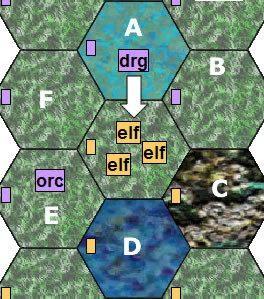Arena
From IFki
Welcome to Arena, the game of ever-changing strategy. This is the Basic Rules page.
- Home
- Rules
- Basic
- Advanced
- QuickGuide
- Variants
- Cards
- Forum
- History
- Play the game
Basic Rules
Contents |
The Board
The board is 17 hexes arranged in three rows: 6-5-6. At each end of the 5-hex line are special areas that hold each player's King. The board begins with the line of hexes in the middle as River terrain, and the other hexes as Grassy terrain. All hexes start with an elevation of 0.
Object
The first player who moves one of their creatures onto the area containing their opponent's King wins.
Creatures
Each player has one or more creatures in their army. Every creature has three characteristics:
- Power - fighting ability for offense or defense
- Move - how many hexes per turn the creature can move across the ground (also called Land Speed)
- Terrain - what terrains the creature can move through. Possible values are:
- Rocky - can move through Rocky, Grass, and River
- Forest - can move through Forest, Grass, and River
- Grass - can move through Grass and River
- All land - can move through all terrains but Water
- Water - can move through Water and River
- All - can move through all terrain
Example: In the image above, there is an orc on Rocky terrain, and a centaur and sea serpent on River. The hex between the centaur and the serpent is Water.
An orc has a move of 1 and terrain Rocky, so it could move onto the serpent's hex or onto the Grassy hex directly below it, but it could not move onto the Water hex or move all the way to the centaur.
A sea serpent has a move of 1 and terrain Water, so it could move into the Water hex but not the orc's hex, nor to any of the Grassy hexes around it.
A centaur has a move of 2 and terrain All land. It couldn't move into the Water hex, but it could move into the orc's hex in a single turn.
Start
Players begin by placing their creatures in any hex next to their King. Any number of creatures may occupy a single hex. Creatures may not be placed on a terrain which they could not legally enter.
Example: Player 2's elves may be placed in any of the three bottom hexes, since they can occupy either Grass or River. His shark must be placed in the River hex, since it is a water creature.
Sequence of Play
Terrain Change
The player whose turn it is adds up the hexes under their control. Any hex currently occupied by a player's creatures, or any hex that was last passed through or occupied by a player's creatures, is under that player's control.
Example: Hexes controlled by player 1 are marked in purple. Those controlled by player 2 are marked in orange. Player 1 controls 5 hexes, player 2 controls 6 hexes, and 6 hexes are uncontrolled.
The total number of hexes under the player's control becomes their "terrain pool," which can be spent on changing the terrain and elevation of the hexes on the board. The player may use their terrain pool to "purchase" terrain changes as follows:
- The cost to change a hex under the player's control is 4 hexes
- The cost to change a hex under no one's control is 6 hexes
- The cost to change a hex under the opponent's control is 8 hexes
Example: In the image above, player 1 could each change 1 hex under their control. Player 2 could change one of the hexes under their control, or one of the center hexes under no one's control.
Terrain may change in any of four ways. Each change must be paid for separately.
- Grass becomes Forest, Rocky, or River
- Forest, Rocky, or River becomes Grass
- River becomes Water
- Water becomes River
The map below shows how the terrain and elevation of a given hex may change. Each step is a change that must be paid for separately.
Example: A change could take a hex from Grass to River, Forest, or Rocky (but not to Water).
Depending on the player's number of hexes of control, a player may change multiple hexes (or the same hex multiple times).
The two areas at either end of the board do not count as hexes for purposes of terrain change.
Example: a player controls 8 hexes. He chooses to change an uncontrolled hex from Grass to Rocky (costing 6).
Example: a player controls 11 hexes. She chooses to change one of her hexes from Grass to Water (costing 4 + 4 = 8).
Movement
One player is randomly chosen to move first at the beginning of the game. On that player's first move, the player may only move creatures whose total power is half the total power of all the player's creatures.
Example: a player with 3 elves (Power 1) can only move one of them.
Example: a player with 4 kobolds (Power 0) and one orc (Power 1) could move all 4 kobolds, but not the orc.
On all future moves, each player whose turn it is may move all of their creatures during their turn.
If a player moves into or through an empty hex, that player then controls that hex until their opponent moves a creature into the hex.
Creatures may attempt to move up to their full movement into or through any hex whose terrain type they can enter.
Creatures may move into or through hexes occupied by their fellow creatures. They may move into, but not through, hexes occupied by their opponent's creatures.
Example: the centaur above (Move 2) could move into the hex containing the human and orc and continue moving into hex A, because all creatures are controlled by the same player; however, if the centaur instead chose to move into the hex containing the opponent kobold, the centaur's move would end there. The centaur may not move into the Water hex, because it cannot enter that type of terrain.
Combat
Once movement is completed, any creatures who occupy the same hex as an opponent engage in combat. Each player adds up the total power of any creatures they have in that hex.
Example: a player moves 4 orcs (Power 1 each) into a hex occupied by an opposing ogre (Power 3). The first player has Power 4, the second player Power 3.
If one of the players has a higher total power:
- The player with the higher power wins, and his creatures remain in the hex.
- The player with the lower power loses. One creature from the losing side is killed and removed from play (decided randomly).
- The remaining creatures of the losing player (if any) must retreat.
Example: 4 orcs (total Power 4) defeat an ogre (Power 3) and kobold (Power 0). The kobold is randomly chosen to die, and the ogre is forced to retreat.
If the two players have the same total power
- No creatures are killed.
- Any creatures who moved into the hex this turn must retreat.
Example: An elf (Power 1) moves into a hex containing an Evil Mound (Power 1). Neither is killed, but the elf is forced to retreat back to where he came.
Retreat
In the retreat phase, any creature who has been defeated in combat and not killed, and any creature that is currently occupying a terrain type the creature could not enter, must retreat.
The only exception is if the terrain type changed at the beginning of this turn.
Example: Player 2's ogre (terrain type Rocky) occupies a River hex. Player 1 changes the hex from River to Water. The ogre does not need to retreat at the end of Player 1's turn, but must retreat at the end of Player 2's turn.
Each creature's retreat is determined separately and simultaneously.
Attacking creatures who are forced to retreat must retreat back to the hex from which they last came. If it is of a terrain type that they cannot enter, the retreating creature dies.
Example: 4 orcs attack a giant and fail. One orc dies, and each of the rest retreats back to the hex it attacked from.
Defending creatures who are forced to retreat must retreat to an adjacent hex under their player's control (randomly determined), assuming that there is at least one valid retreat (see below). If a creature has no valid retreats to adjacent hexes under their player's control, it retreats to a valid adjacent hex not under their control (randomly determined).
A hex is a valid retreat for a defending player if it is not:
- any hex of a terrain type or elevation they cannot enter
- any hex from which they have previously retreated this turn
- any hex which contains an opponent's creature
- any hex from which an opponent moved into their hex this turn
If a creature has no valid adjacent hexes to retreat to, it dies.
Example: a dragon attacks 3 elves and wins. One elf dies, and the other two are forced to retreat. The elves cannot retreat to hexes C or D because they cannot enter that terrain type, so the elves must retreat to hexes that the player does not control. They cannot retreat to hex A because the dragon moved from that hex, and they cannot retreat to hex E because it is occupied by an enemy creature. So each elf is randomly assigned to retreat to either hex B or hex F.
If a creature has 0 move, it may not retreat, and dies if forced to.
If two or more opposing creatures retreat to the same hex, combat occurs again, with the same rules as in the combat phase, and the cycle of retreats and combat continues until no creature shares a hex with an opponent.
Creatures may not retreat to the hex containing their opponent's king.
Winning
If one of the player's creatures is in the hex occupied by their opponent's King, that player wins.
Starter Games
- Game 1: 3 zombies (all terrain, power 1, move 1) vs. 4 orcs (rocky, power 1, move 1)
- Game 2: 1 giant (rocky, power 5, move 1) and 2 orcs vs. 5 elves (forest, power 1, move 1)
- Game 3: 1 centaur (forest, power 1, move 2) and 3 elves vs. 2 ogres (rocky, power 3, move 1) and 1 kobold (rocky, power 0, move 1)
Game Mechanics
There is a prototype gameboard of Arena which you can use to play the game with another player who is logged in at the same time. The gameboard is only going to make sense if you've read these rules thoroughly or are being helped by someone who has. Here are some important things to keep in mind when playing on that board:
- The board does not know the rules of the game. It won't teach you the game, it won't stop you from doing an illegal move, it won't resolve combat for you. It's very primitive, basically just a way for you to convey your moves to your opponent. It assumes that both of you know how to play already.
- You must click "Put Move" to push your move out to your opponent, and "Get Move" to get your opponent's move.
- To change a hex's terrain or elevation, click on the small square to the left of the hex, as seen in many illustrations above. That square will also change color to mark who has controlled the hex, but again, it will not necessarily be accurate - it's only a memory aid.
